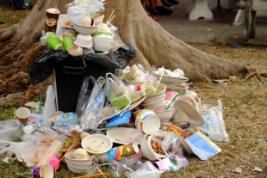Environmental Issues in tourism Industry
The tourism industry grew to be the most dominant sector in the economy during a period of only 10 years, marking a new epoch in the economic history of the Maldives. The industry increased its capacity from about 200 beds in 1972 to over 11, 300 beds in 1982, distributed among over 74 resorts, 50 guest houses and 40 yachts. The Maldivian tourist product is primarily based on sea, sand and sun. Thus, over 90% or 10, 300 beds are on island resorts. Tourism now contributes over 17% to GDP, generating 70% of all foreign currency earnings and 40% of the government revenue.
Government, aware of the potentiality of the industry, institutionalized the industry in the 1980s. Since then Maldives has been cautious in tourism expansion. The prime reasons for controlled developments are to avoid flooding of the markets with Maldives tourist products and to avoid deterioration of the quality of services. This will ensure that the rate of acculturation does not exceed the society's absorption capacity and to avoid non-sustainable exploitation of natural resources.
Tourism development in Maldives has been based on sustainable exploitation of resources. Natural capital is to be managed so that a stock of natural resources, no less than that which was inherited from previous generations, is left for the use of future generations. The same principle applies to the intangible resources that are sold as part of the tourist product: the peace and harmony of the society, local culture, arts and crafts, traditions and livelihood. Hence, strict measures are taken to minimize the negative impacts to society and the environment but the economic goals of employment and income generation are not compromised.
However, such measures, especially those aimed at protection and proper management of the environment, require adoption of greener technologies. These measures often have short term costs. Therefore, in formulating regulations that require investments, government follows a policy of gradual enforcement. Regulations are developed over time and are implemented progressively, to the extent that the industry can adjust to these measures.
With only one exception, each island in the Maldives hosts a single resort. Hence, each resort is an autonomous unit that provides its own power, sewage and garbage disposal arrangements and water supply. Ecologically, Maldivian islands are at the stage of island formation where the crust or the original volcanic core has been completely submerged, leaving only the collection of unconsolidated coral sand over the reef above the surface of the ocean. Consequently, these islands are extremely dynamic systems. Even without anthropogenic interference they are often unstable.
Continued growth of reefs and healthy existence of the surrounding marine life is essential for the existence of the islands. Reefs provide the supply of coral debris and sand to the shores, sustaining the littoral processes (long shore drift and beach drift) which result in accretion and erosion around the island. In this process, a part of the sediment is retained by the vegetation and results in growth of the islands. A loss to the sediment budget due to retention of sand is compensated by the supply from the reef. This is an extremely complex process involving a number of contributing factors including coastal currents; waves; climate; location of the island on the atoll; health of the reef and its habitats; configuration of the coastline; type and size of the reef flat; depth, size and biological environment of the inner lagoon; and type of coastal vegetation.
In an imbalanced accretion and erosion process, deposition and accretion may occur within the inner lagoon; on the reef flat or even may cause sediments to fall over the reef edge while the island experiences sever erosion. This in turn may change the existing coastal process because of a change in one or many of the factors that keep the island and reef ecology at an equilibrium.





